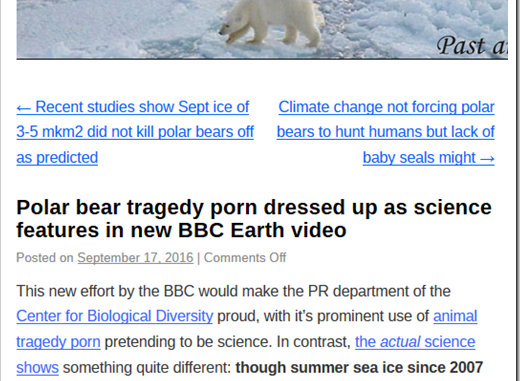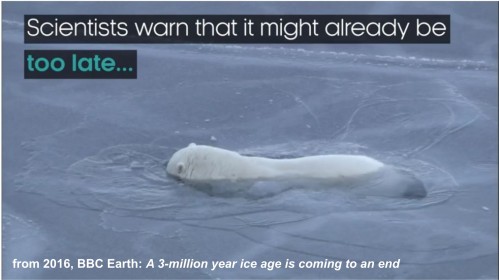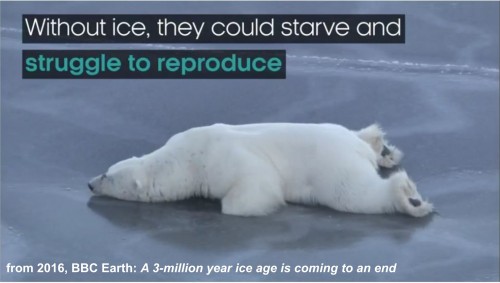
Polar bear tragedy porn dressed up as science features in new BBC Earth video
Dr Susan Crockford attacks the latest dreadful piece of propaganda from the BBC:
This new effort by the BBC would make the PR department of the Center for Biological Diversityproud, with it’s prominent use of animal tragedy porn pretending to be science. In contrast, theactual science shows something quite different: though summer sea ice since 2007 has declined to levels not predicted until 2040-2070, there has been virtually no negative impact on polar bear health or survival, a result no one predicted back in 2005.

Bizarrely entitled “A 3-million-year ice age is coming to an end“ (15 September 2016), this slick video pretends it’s promoting the recently released paper by Harry Stern and Kristen Laidre (2016) that got a lot of media attention last week (see here and here).
Who exactly suggested the profound prophesy stated in their chosen title, the BBC Earth folks don’t say: the Stern and Laidre paper certainly does not. And the use of a bear that appears to drown before our eyes is Hollywood-style emotional manipulation. Note the careful use of “might” (above) and “could” (below).

Watch the videos below and weep not for the plight of the polar bear, but for the downfall of science journalism.
“A 3-million-year ice age is coming to an end : A dramatic animation shows how much of the Arctic sea ice has melted away in the last 35 years. The ice loss poses a terminal threat to polar bears” (15 September 2016, BBC Earth).
About the paper
That summer ice loss has occurred is not news: this paper simply defines a new standardized method of describing summer sea ice loss across all polar bear habitats. As I pointed out previously, the IUCN Polar Bear Specialist Group (PBSG) added this metric to it’s polar bear status table in early 2015 (more than a year before this paper describing the method was submitted for peer review).
The Stern and Laidre method includes June as “summer” for Lancaster Sound through Southern Hudson Bay (even though bears in the Central Canadian Arctic (like Lancaster Sound) continue to feed successfully in June and July but bears in Southern Hudson Bay have pretty much finished feeding by the end of May): most Arctic analyses consider June to be spring (e.g. Pilfold et al 2015).
Stern and Laidre re-define “Summer” sea ice as June through October. Their supplemental dataprovide details of sea ice changes for all polar bear subpopulations but not a region by region prediction of future ice loss.
Stern and Laidre (2016:13) state (my bold):
“General circulation models (GCMs) predict ice-free Arctic summers by mid-century or sooner (IPCC, 2013; Overland and Wang, 2013). Spring sea-ice retreat will continue to arrive earlier and fall sea-ice advance will continue to arrive later, with no reversal in sight. Barnhart et al. (2015) used daily sea-ice output from a 30-member GCM ensemble, driven by the business-as-usual emissions scenario (RCP 8.5), to map the annual duration of open water in the Arctic through 2100. They found that by 2050 the entire Arctic coastline and most of the Arctic Ocean will experience an additional 1 to 2 months of open water per year, relative to present conditions, which is consistent with extrapolation of the trends in Table 3.
…
This study offers standardized metrics with which to compare polar bear habitat change across the 19 subpopulations and provides a starting point for including sea-ice habitat change in circumpolar polar bear management and conservation plans.”
There is no proof provided in the paper that this new method of defining sea ice changes is biologically significant or superior to a region-by-region analysis – no one has ever done such a thing before and it remains to be seen if it is a useful addition to science.
The University of Washington video promoting the Stern and Laidre paper is below:
References
Pilfold, N. W., Derocher, A. E., Stirling, I. and Richardson, E. 2015. Multi-temporal factors influence predation for polar bears in a changing climate. Oikos 124 (8):1098-1107. http://onlinelibrary.wiley.com/doi/10.1111/oik.02000/abstract
Stern, H.L. and Laidre, K.L.. 2016. Sea-ice indicators of polar bear habitat. The Cryospheredoi:10.5194/tc-10-2027-2016 Pdf here, Supplemental data here. [Open access]
This article was picked up from Not A Lot Of People Know That


